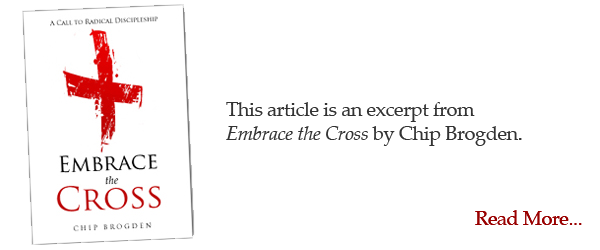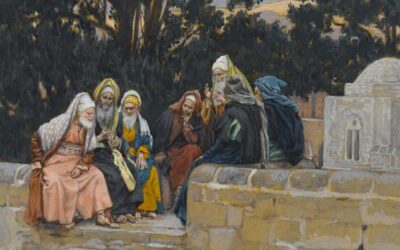that you should follow His steps” (I Peter 2:21).
While this is true enough, it can be misleading. A better question to ask is, “Have you accepted the two-fold work of the Cross?” Try this out on a few Christians and you will probably get a puzzled reply along the lines of, “What is the two-fold work of the Cross?” That is because most people are only familiar with one side of the Cross, not both sides.
For many years I was only taught one aspect of the Cross – that is, the cross on which Jesus died for me. That is all I knew, and so that is all I taught. On this cross He was crucified as my substitute. He laid down His life for me. His precious blood was shed for the forgiveness of my sins. Not only that, but the Bible says that God laid on Jesus the iniquity of us all. John the Baptist calls Him, “The Lamb of God Who takes away the sins of the whole world.”
By identifying with His sacrificial death, He becomes our Substitute. We enter into His finished work. We are made one with Him there on the Cross. Thank God we do not have to pay this debt, for it has been paid for us. We do not have to go to the Cross and be crucified for our sins.
I would suggest that almost every Christian is familiar with this aspect of the Cross. It is the foundation of evangelicalism, the basis of millions of sermons to millions of believers. It is the truth, and we thank God for the truth whenever it is proclaimed.
There is another side to this Cross, another dimension of the same truth, which is not as well-known, and is hardly preached at all. As a result, many believers are content to embrace the “Sinner’s Cross”; that is, they have confessed Jesus as Savior, and they understand and accept Him as their Substitute. It is certainly true that Jesus is our Substitute, and that He died on the Cross for us. But as we have said, there is a two-fold work of the Cross.
Peter alludes to this two-fold work when he writes, “Christ also suffered for us, leaving us an example, that you should follow His steps.” Christ suffered FOR us; that is the first aspect. But He left us an EXAMPLE; that is the second aspect.
So the work of the Cross is two-fold. First, Jesus is our Substitute. Secondly, He is our Example. In the first case, He took up the Cross. In the second case, I take up the Cross. The first work of the Cross is for the Sinner; the second work of the Cross is for the Disciple.
Jesus said that the way to Life is through a narrow Gate and a difficult Path. The Gate is only the beginning of the journey; it is not the destination. So we must have both the Gate and the Path. One is not complete without the other. Once we are through the Gate, there is a Path for us to walk. The Gate makes it possible for us to walk the Path, but the Gate is incomplete without the Path. The Life is at the end of the Path, not at the beginning.
This corresponds to the two-fold work of the Cross. The “Sinner’s Cross” is the Gate. Because Jesus is my Substitute, I can now walk the Path. The “Disciple’s Cross” is the Path. Now I am following His example. Can you see the difference?
Jesus says the way to Life is through a Narrow Gate and a Difficult Path. The Narrow Gate is Christ. It is Narrow because He is the Only Way. But why is the Path so difficult? Partly because it is much easier, much more appealing, to accept Jesus as a Substitute than to accept Him as an Example. Stated differently, it is much more appealing to accept Jesus as Savior than to accept Him as Lord. With a simple prayer I can acknowledge Him as my Substitute and Savior. But to make Him my Example and my Lord, to actually walk in His footsteps, is not so appealing.
Why? In the first case I simply embrace the “Sinner’s Cross” and everything is done for me. But in the second case I must take up the “Disciple’s Cross” and actually follow in the steps of the Master. It only takes a moment to pass through the Gate, but the Path takes a lifetime of walking.
Peter wrote of this two-fold work of the Cross, but we see in Matthew 16 that he did not always have this understanding. In Matthew 16 we see Jesus as our Substitute and our Example all in one chapter. First there is Jesus as the Substitute. He begins to show His disciples that He must go to Jerusalem, suffer many things, be killed, and raised the third day. For His sins? No, for our sins. So in this He is our Substitute.
Peter, taking offense over this, pulls Jesus aside and begins to rebuke Him. Imagine! Peter is rebuking the Lord Jesus over this issue of the Cross. It is, indeed, a difficult thing to comprehend. But Jesus turns and rebukes Peter. Yes, it will be so. I will go to Jerusalem and die for the sins of the world. I must complete My substitutionary work.
But the two-fold work of the Cross goes deeper than the physical death of Jesus. And so Jesus immediately begins to speak to them, not about HIS Cross, but about THEIR Cross:
“Then Jesus said to His disciples, ‘If anyone desires to come after Me, let him deny himself, and take up his cross, and follow Me. For whoever desires to save his life will lose it, but whoever loses his life for My sake will find it'” (Matthew 16:24,25).
Peter objected to the death of the Lord Jesus and wanted to prevent His crucifixion. The Lord Jesus responded that not only must the Master be crucified, but anyone who desired to follow after the Master would, of necessity, have to take up their Cross as well.
Peter eventually learned this lesson, and it is time we learned it as well. Jesus is both my Substitute and my Example. Jesus, is both my Savior and my Lord. Jesus is both the Narrow Gate and the Difficult Path.
If there is any doubt as to the reason for a lack of power, a lack of joy, a lack of faithfulness, a lack of Spirit-and-Truth today, we need only examine a person’s ultimate attitude towards the Cross. Is the Cross, to them, something that Jesus saved them FROM, or something that Jesus saved them FOR? The fruit, or the lack thereof, tells the whole story. For there never will be, and there never can be, any fruitfulness apart from embracing the two-fold work of the Cross.
The question will of course arise: can Jesus be Savior, but not be Lord? Can I accept the salvation but not the discipleship? Can I enter the Gate but not walk the Path? And the underlying concern is really this: can I pray the Sinner’s Prayer, live any way I please, and still go to heaven when I die?
The question itself is very revealing in the ones who ask it. Consider that it takes two beams to make a Cross; one beam is not enough. If we accept only half of the two-fold work of the Cross then we have not truly embraced the Cross. If we continue to preach an easy Gospel and bring sinners to an easy Jesus by having them pray an easy prayer then we are guilty of propagating another gospel, a false gospel, a Gate without a Path.
The Rich Young Ruler came to Jesus with the exact same concern: what must I do to inherit eternal life? His primary concern was going to heaven when he died. For many Christians that is the ultimate objective and the motivation behind everything they do. In actuality, Jesus said comparatively little about “going to heaven when you die.” But He had quite a bit to say about being obedient to the will of God and producing fruit while you’re still living here on earth.
To the Rich Young Ruler who wanted to be saved, Jesus offered discipleship, not salvation:
“Then Jesus, looking at him, loved him, and said to him, ‘One thing you lack: Go your way, sell whatever you have and give to the poor, and you will have treasure in heaven; and come, take up the cross, and follow Me.’ But he was sad at this word, and went away sorrowful, for he had great possessions. Then Jesus looked around and said to His disciples, “How hard it is for those who have riches to enter the kingdom of God!'” (Mark 10:21-23).
Not “how EASY for them to enter the Kingdom of God”, but “how HARD it is”. The two-fold work of the Cross is a hard saying for rich and for poor alike. Many turn away sad and sorrowful at the thought of taking up the Cross as a disciple. For that reason, only the first half of the two-fold work of the Cross is preached.
I suspect that the Rich Young Ruler would have eagerly accepted Jesus as his Substitute – because the subtle implication is that since Jesus died on the Cross, I won’t have to die! But like all the other suggestions of the adversary, this too is only a partial truth. For the whole truth is that the work of the Cross is two-fold, and we can embrace both, or neither, but we cannot keep one and discard the other.
You may be concerned that if we make salvation contingent on discipleship then fewer people would get saved. That’s exactly the point. This is precisely what Jesus meant when He said, “Few find it” (Matthew 7:14b).
So what are we do to? Should we continue to give false comfort to those who are unwilling to take up their Cross, deny Self, and follow Jesus? By no means. Instead, let us endeavor to show others, by example, that the only way to Life is through Death; the only way to reign with Him is to suffer with Him; not those who hear, but those who hear and put into practice, are His true disciples.
May the Lord Jesus Himself bear witness of these things, that they are true. Amen.












